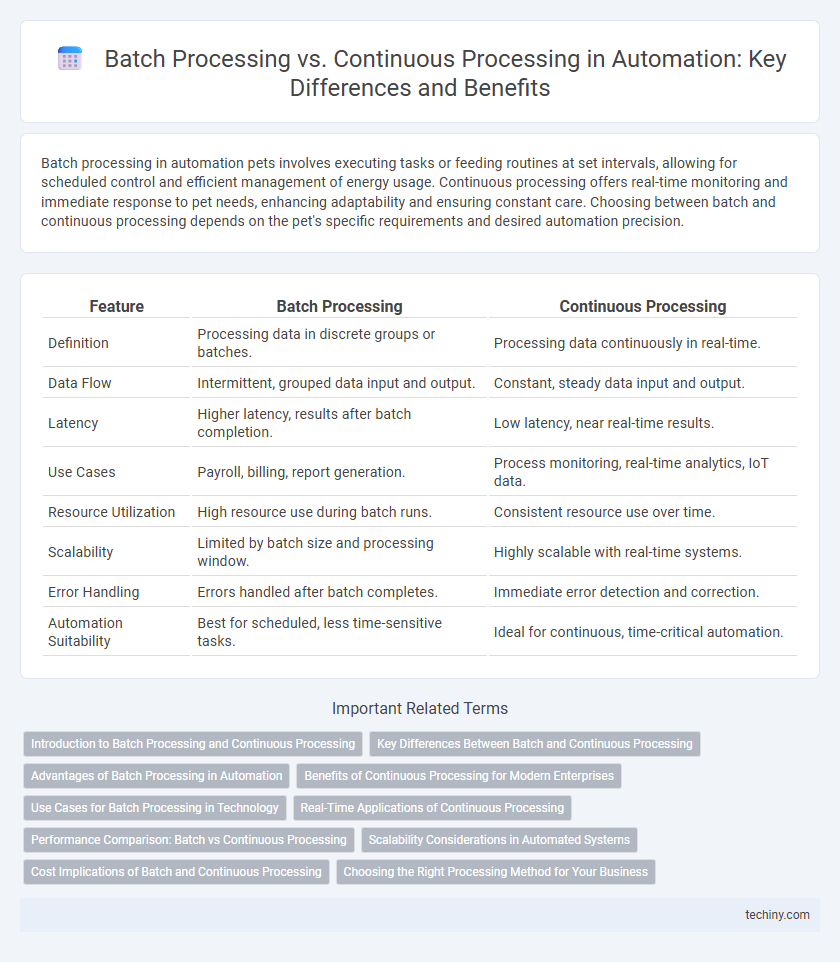Batch processing in automation pets involves executing tasks or feeding routines at set intervals, allowing for scheduled control and efficient management of energy usage. Continuous processing offers real-time monitoring and immediate response to pet needs, enhancing adaptability and ensuring constant care. Choosing between batch and continuous processing depends on the pet's specific requirements and desired automation precision.
Table of Comparison
| Feature | Batch Processing | Continuous Processing |
|---|---|---|
| Definition | Processing data in discrete groups or batches. | Processing data continuously in real-time. |
| Data Flow | Intermittent, grouped data input and output. | Constant, steady data input and output. |
| Latency | Higher latency, results after batch completion. | Low latency, near real-time results. |
| Use Cases | Payroll, billing, report generation. | Process monitoring, real-time analytics, IoT data. |
| Resource Utilization | High resource use during batch runs. | Consistent resource use over time. |
| Scalability | Limited by batch size and processing window. | Highly scalable with real-time systems. |
| Error Handling | Errors handled after batch completes. | Immediate error detection and correction. |
| Automation Suitability | Best for scheduled, less time-sensitive tasks. | Ideal for continuous, time-critical automation. |
Introduction to Batch Processing and Continuous Processing
Batch processing collects and processes data or materials in defined groups or batches, enabling systematic handling of large volumes at scheduled intervals, ideal for tasks requiring consistent, repeatable outputs. Continuous processing operates in an ongoing, non-stop flow, maintaining constant input and output streams, which optimizes production efficiency and reduces downtime in industries such as chemical manufacturing and food processing. Both methods leverage automation technology to enhance accuracy, speed, and scalability in industrial operations.
Key Differences Between Batch and Continuous Processing
Batch processing involves handling large volumes of data or materials in discrete groups at specific intervals, while continuous processing operates non-stop, managing inputs and outputs simultaneously. Key differences include batch processing's suitability for variable or seasonal production with flexibility in scheduling, contrasted with continuous processing's design for consistent, high-volume production with minimized downtime. Automation in batch processing emphasizes precise control over individual batches, whereas continuous processing relies on real-time monitoring and steady state operation to optimize efficiency.
Advantages of Batch Processing in Automation
Batch processing in automation offers significant advantages such as enhanced control over product quality through precise monitoring and adjustment between batches. It allows for greater flexibility in handling varied product types or changing production requirements without halting the entire operation. Furthermore, batch processing optimizes resource utilization by scheduling equipment and labor efficiently, which can reduce downtime and operational costs.
Benefits of Continuous Processing for Modern Enterprises
Continuous processing offers modern enterprises enhanced operational efficiency by enabling real-time data handling and minimizing downtime. It supports scalable production with consistent quality control through automated monitoring systems. This approach reduces inventory costs and accelerates time-to-market, crucial for competitive industries demanding agility and responsiveness.
Use Cases for Batch Processing in Technology
Batch processing is ideal for large-scale data analysis and financial transactions where tasks can be accumulated and processed during off-peak hours to maximize efficiency. Industries such as banking, payroll, and data warehousing rely on batch processing for its ability to handle high volumes of records with consistent accuracy. This method reduces system load and ensures that complex computations, like month-end reports or inventory updates, are completed without real-time constraints.
Real-Time Applications of Continuous Processing
Continuous processing enables real-time data analysis and decision-making by maintaining a constant flow of information, essential for applications like financial trading, industrial automation, and live monitoring systems. Unlike batch processing, which handles data in discrete chunks with inherent delays, continuous processing supports instantaneous response and dynamic adjustments, improving efficiency and accuracy. This approach is critical in environments requiring immediate action and uninterrupted operational control, such as cybersecurity threat detection and autonomous vehicle navigation.
Performance Comparison: Batch vs Continuous Processing
Batch processing handles large volumes of data in discrete groups, which can lead to latency but allows for resource optimization during off-peak hours. Continuous processing, or stream processing, provides real-time data handling, significantly reducing latency and enabling immediate data-driven decisions. Performance benchmarks show continuous processing outperforms batch processing in scenarios requiring low-latency responses and high throughput, while batch remains efficient for complex, resource-intensive computations done less frequently.
Scalability Considerations in Automated Systems
Batch processing scales efficiently for large volumes of data processed at scheduled intervals, allowing for resource optimization during off-peak hours. Continuous processing supports real-time data handling with scalability designed for dynamic workloads and low latency requirements. Automated systems prioritize scalability based on throughput demands, system architecture, and responsiveness to ensure optimal performance in either batch or continuous processing environments.
Cost Implications of Batch and Continuous Processing
Batch processing typically incurs lower initial setup costs but can lead to higher per-unit costs due to downtime and batch changeover inefficiencies. Continuous processing, while requiring substantial upfront capital investment and complex infrastructure, offers reduced operational costs through consistent throughput and minimized labor requirements. Over time, continuous processing generally delivers superior cost-efficiency in high-volume production environments compared to batch processing.
Choosing the Right Processing Method for Your Business
Batch processing excels in handling large volumes of data or transactions at scheduled intervals, making it ideal for businesses with predictable workloads that require efficiency and cost-effectiveness. Continuous processing supports real-time data flow and immediate output, suited for industries demanding constant monitoring and rapid response, such as manufacturing or financial services. Selecting the right method depends on your business's operational needs, data volume, processing speed requirements, and integration capabilities with existing systems.
Batch Processing vs Continuous Processing Infographic

 techiny.com
techiny.com